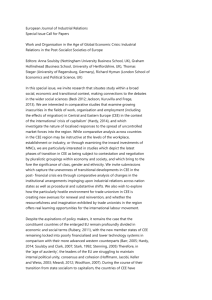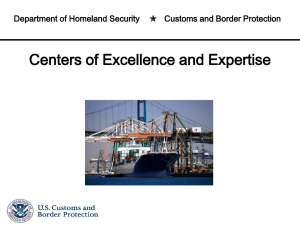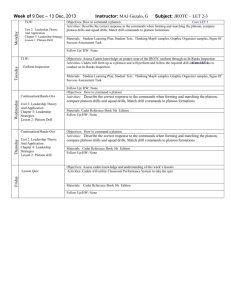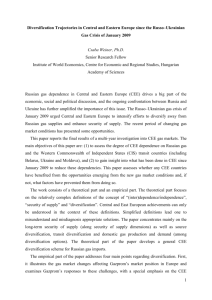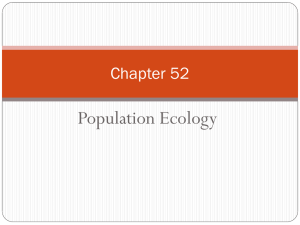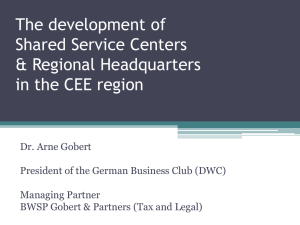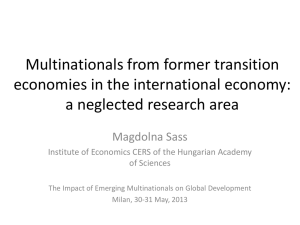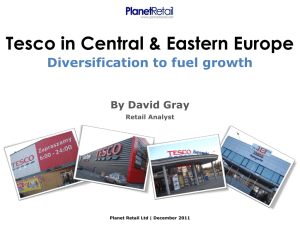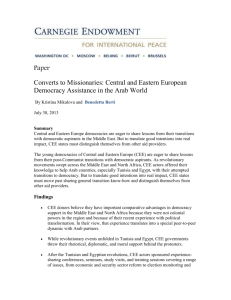Topic 5 - Platoon Dispersion
advertisement
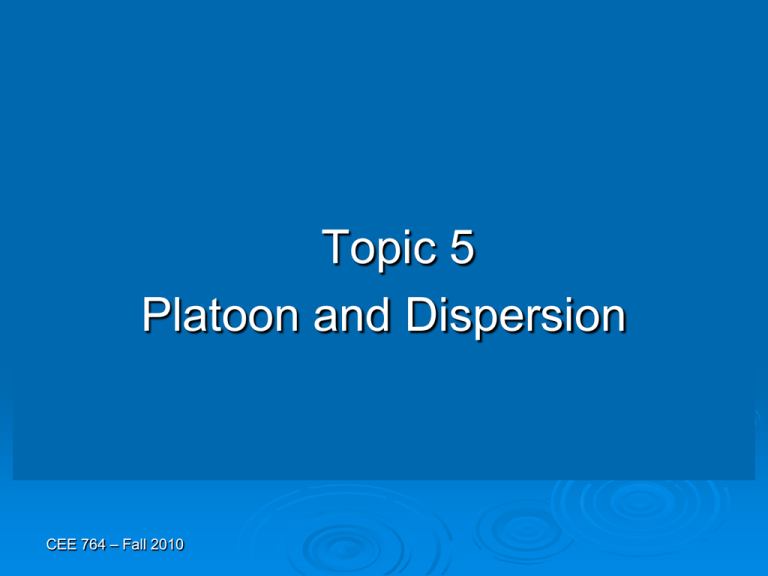
Topic 5 Platoon and Dispersion CEE 764 – Fall 2010 TRANSYT-7F MODEL TRANSYT is a computer traffic flow and signal timing model, originally developed in UK. TRANSYT-7F is a U.S. version of the TRANSYT model, developed at U of Florida (Ken Courage) TRANSYT-7F has an optimization component and a simulation component. The simulation component is considered as a macroscopic traffic simulation, where vehicles are analyzed as groups. One of the well known elements about TRANSYT-7F’s traffic flow model is the Platoon Dispersion model. CEE 764 – Fall 2010 WHY MODEL PLATOON DISPERSION? Platoons originated at traffic signals disperse over time and space. Platoon dispersion creates non-uniform vehicle arrivals at the downstream signal. Non-uniform vehicle arrivals affect the calculation of vehicle delays at signalized intersections. Effectiveness of signal timing and progression diminishes when platoons are fully dispersed (e.g., due to long signal spacing). CEE 764 – Fall 2010 PLATOON DISPERSION MODEL For each time interval (step), t, the arrival flow at the downstream stopline (ignoring the presence of a queue) is found by solving the recursive equation Q(T t ) F qt [(1 F ) Q(T t 1) ] T T , T free- flow travel time (steps) F 1 1 T 0.50 heavytraffic 0.35 m oderate traffic 0.25 light traffic CEE 764 – Fall 2010 % Saturation PLATOON DISPERSION Flow rate at interval t, qt 100 50 0 Time, sec Start Green % Saturation T = 0.8 * T’ 100 Flow rate at interval t + T, Q(T+t) 50 0 Time, sec CEE 764 – Fall 2010 CLOSED-FORM PLATOON DISPERSION MODEL Flow rate, vph s v 0 tq tg C CEE 764 – Fall 2010 Time CLOSED-FORM PLATOON DISPERSION MODEL (1~tq) For 1~tq with s flow Q(T t ) F qt [(1 F ) Q(T t 1) ] Q(T 1) Fq(1) (1 F )Q(T 0) Fs (1 F )Q(T 0) Q( T 2 ) Fs ( 1 F )Q( T 1 ) Fs ( 1 F )[ Fs ( 1 F )Q( T 0 ) ] Fs ( 1 F )Fs ( 1 F ) 2 Q( T 0 ) Q( T 3 ) Fs ( 1 F )Q( T 2 ) Fs ( 1 F )Fs ( 1 F )2 Fs ( 1 F )3 Q( T 0 ) Q( T t ) Fs ( 1 F )Fs ( 1 F )2 Fs ....... ( 1 F )( t 1 ) Fs ( 1 F )t Q( T 0 ) CEE 764 – Fall 2010 CLOSED-FORM PLATOON DISPERSION MODEL (0~tq) (1) Q( T t ) Fs ( 1 F )Fs ( 1 F )2 Fs ....... ( 1 F )( t 1 ) Fs ( 1 F )t Q( T 0 ) (2) (1 F )Q(T t ) (1 F )Fs (1 F )2 Fs ....... (1 F )(t 1) Fs (1 F )(t ) Fs (1 F )(t 1) Q(T 0) (1) – (2) FQ( T t ) Fs ( 1 F )t Q( T 0 ) ( 1 F )t Fs ( 1 F )( t 1 ) Q( T 0 ) Fs[ 1 ( 1 F )t ] Q( T 0 ) ( 1 F )t F Q( T t ) s[ 1 ( 1 F )t ] ( 1 F )t Q( T 0 ) CEE 764 – Fall 2010 CLOSED-FORM PLATOON DISPERSION MODEL (1~tq) Q( T t ) s[ 1 ( 1 F )t ] ( 1 F )t Q( T 0 ) Q(T 0) 0 Q(T t ) s[1 (1 F )t ] Qs ,max Q(T tq ) s[1 (1 F ) q ], t Maximum flow downstream occurs at T+tq with upstream s flow CEE 764 – Fall 2010 For 1~tq with s flow t 1 ~ tq BEYOND (1~tq) From the original equation: Q( T t ) s[ 1 ( 1 F )t ] ( 1 F )t Q( T 0 ) Q(T 0) Qs,max Q(T t ) (1 F ) s no longer exists, but zero flow upstream t t q Qs ,max t = tq +1 ~ ∞ •This is mainly to disperse the remaining flow, Qs,max. Upstream flow is zero •The same procedure for the non-platoon flow •The final will be the sum of the two CEE 764 – Fall 2010 EXAMPLE Vehicles discharge from an upstream signalized intersection at the following flow profile. Predict the traffic flow profile at 880 ft downstream, assuming free-flow speed of 30 mph, α = 0.35; β = 0.8. Use time step = 1 sec/step 3600 Flow rate, vph 1200 0 CEE 764 – Fall 2010 16 28 C=60 sec Time Flow Rate, vph Platoon Dispersion (Start of Upstream Green) 4000 3500 3000 2500 2000 1500 1000 500 0 13 15 17 19 21 23 25 27 29 31 33 35 37 39 41 43 45 47 49 51 53 55 57 59 61 63 65 67 69 71 73 75 77 79 81 83 85 green CEE 764 – Fall 2010 red Time Slice, sec


